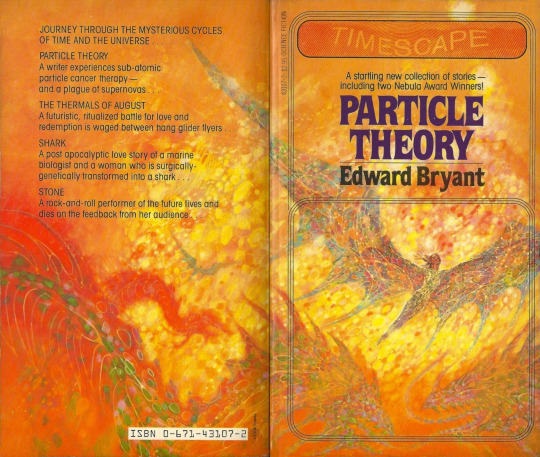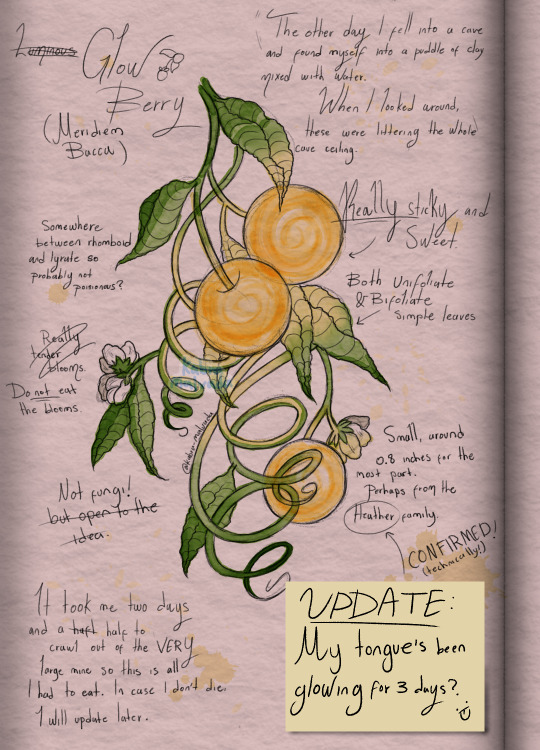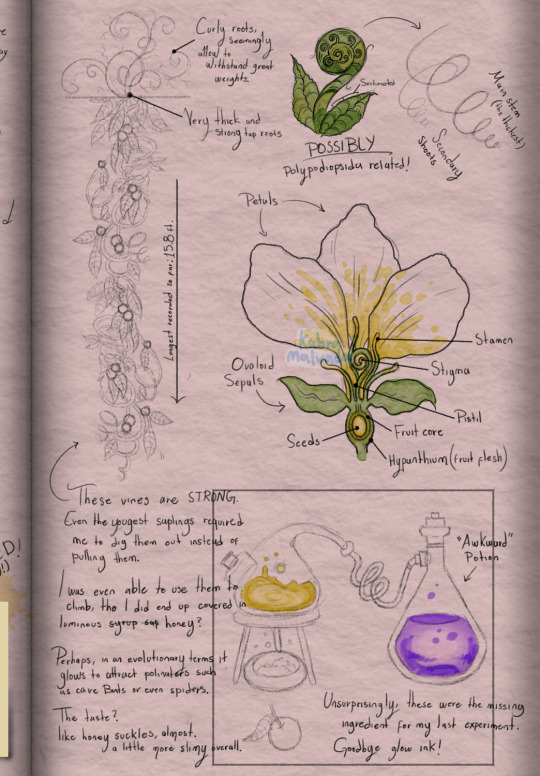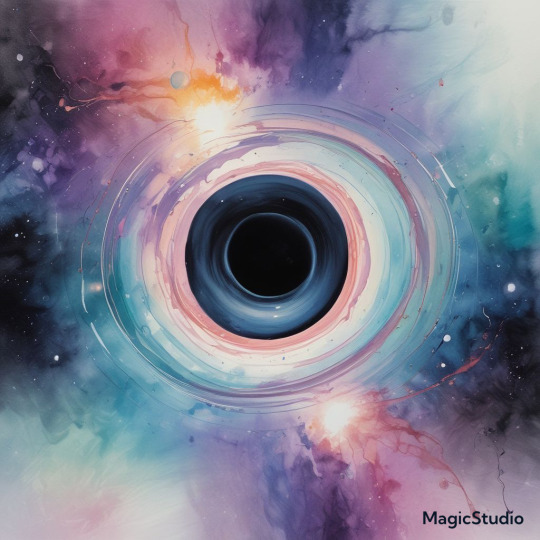#particle theory
Explore tagged Tumblr posts
Text


Wraparound cover art by Richard Powers (1921-1996) for Edward Bryant, Particle Theory (Timescape, 1981).
591 notes
·
View notes
Text
Yoooo, Christopher Nolan uses glitter as symbolism in Oppenheimer!

Music and abstraction show us Oppenheimer’s mindset and progress:
Shots of glitter in motion replicate particles and space, a direct reference to Heisenberg’s Quantum Theory of Fields and Elementary Particles
When there’s rumbling, Oppie is conflicted or failing
When there’s orchestral music, Oppie is in the zone or has succeeded
BONUS: the lack of sound during the Trinity Test is not only accurate to light being faster than sound, but a point of reflection on the climactic edge of all his efforts, before everything falls down.
#oppenheimer#christopher nolan#movie analysis#glitter#wwii history#barbenheimer#quantum physics#particle theory#science#symbolism#analysis fridays
70 notes
·
View notes
Text
I've never felt a connection to past lives. Well more accurately I've never felt a strong remembrance of past lives. But when I heard about the concept I always thought, we'll pieces of us were definitely pieces of something else in the past, and I definitely think each particle has consciousness so sure we've probably been lots of things before and what we are now is probably comprised of many parts of many different past things.
4 notes
·
View notes
Text
going wild on a saturday night
*glass of bourbon*
*wikipedia page for 'photon'*
#particle wave theory of light is like#wow can't believe light is bisexual...good for her#ask me about the wonders of the quantum realm#do Not ask me about the math for the quantum realm#we don't need it#just vibes
17K notes
·
View notes
Text
youtube
couldn't stop watching once i pressed play.
0 notes
Text

#quantum mechanics#string theory#waveform#waves and particles#shrodinger#max planck#as above so below#yin yang#micro macro#aesthetic#style#beauty#life#perception
27 notes
·
View notes
Text

The mighty, mighty atom.
#animation#vintage animation#atoms#the atom#science#physics#protons#electrons#neutrons#atomic nucleus#nucleus#basic particles#matter#atomic energy#quantum mechanics#quantum physics#nuclear force#electromagnetic force#atomic theory#electron cloud
71 notes
·
View notes
Text
Ok here's my theory as to what the three types of time fuckery meant in Murders in Space:
Time dilation
This one's pretty straightforward. It's the good ol' "travelling close to the speed of light causes the traveller to experience time at a slower rate" thing that some of us might've learned in high school. Not much to say about that.
Time dilution
The way Tom described it made it sound like time dilution is more extreme than time dilation, so I have two theories, either:
time dilution is just an extreme case of time dilation (i.e. what happens when you travel at a speed extremely close to the speed of light, such as 0.99c for example), or;
time dilution is what happens when you travel at the speed of light. Now, this is physically impossible in our world since travelling at light speed would require infinite energy, but let's just say that some crazy scifi shit allows this to happen.
Option 2 would mean that time dilution would cause the scientists to basically stop perceiving time. From their perspective, time intervals would be infinitely large and distances would be infinitely small,
But honestly, I'm the most unsure about this one. Time dilution seems similar enough to time dilation for AJ's scientist character to confuse them, but also option 1 seems kind of redundant? Since time dilation works in the same way when you're travelling at say 0.7c compared to 0.99c, so I'm more inclined to believe option 2.
Time penetration
Judging from how Mary seemingly teleported to the spacecraft, my guess is that time penetration is what happens when you travel at a speed faster than the speed of light. Again, this is physically impossible in our current world, but let's just say that Mary is a genius scientist who's able to break the laws of physics. This one actually makes a lot of sense considering these points:
Mary was able to teleport, which is what scientists have hypothesised would happen if one were to travel faster than light speed.
It would make sense why Mary spent so long trying to get to her husband. Literally breaking the laws of physics isn't a project that can be finished in a couple of months.
Also the whole "time penetration is impossible" thing because yeah...travelling faster than the speed of light is considered to be impossible.
So yeah, I'm actually pretty confident with this one.
BUT HEY, THAT'S JUST A THEORY! A SHOOT FROM THE HIP THEORY! Thanks for reading this incredibly self-indulgent post :]
#shoot from the hip#murders in space#why am I analysing the physics in an improvised play made by one english major and three drama majors? good question.#the answer is because I'm a freaking nerd#also bonus fun fact: scientists may have actually found particles that can travel faster than the speed of light#it's still just a hypothesis but that's insane#like we might be approaching a paradigm shift in physics that's on par with einstein's theory of relativity
50 notes
·
View notes
Text

🔆°⁖◊●Glow Berries Botanic Study●◊⁖°🔆
Page 1 & 2/? Close ups under the cut!


Thinking of which I should do next rn, either sweet berries or mushroom trees.
#glow berries#minecraft#minecraft fanart#botanic illustration#botanic art#kabra art#at first I had the theory these were fungi related thanks to the lush particles they give off#but then I remember you can use the berries to plant more of these so they must have seeds
43 notes
·
View notes
Text

some physics valentines from your favourite plant biology blog. may your love last longer than the half-life of a proton
#particle physics#i made these a few years ago back when i was still in the depths of e&m hell#good times#hope u guys enjoy them#valentines day#im aroace but its ok my love for physics is mediated by gauge bosons not romantic attraction#physics#high energy physics#math#mathblr#linear algebra#maths#string theory#i guess lmAO??
30 notes
·
View notes
Text

#light#waves#light particles#cats#science#energy#enlightenment#gravitational waves#quantum physics#simulated reality#simulated universe#simulation theory#holographic universe#consciousness#quantum mechanics#quantum leap#esoteric#occult#the matrix#whimsical#whimsicore
20 notes
·
View notes
Text
anyone applying to grad school feel like their list is wayyy too unrealistic? idk whenever i do grad app stuff, i take d10 damage from impostor syndrome. (and i have to rlly do grad app stuff now so guess what's happening)
#physics#min vs college#min vs fa24#min vs grad apps#idk how overcome the energy barrier#ughhhh its so despairing#idk if im gonna get in anywhere its so scaryyyyyyy#particle theory isnt a real job :(((((
19 notes
·
View notes
Text
Antimatter is not that weird. Or alternatively, particle physics in general is that weird.
8 notes
·
View notes
Text

Cosmic Genesis: How Black Holes Might Be Giving Birth to New Universes
The human quest for understanding the universe has led to numerous groundbreaking discoveries, each weaving a more intricate tapestry of our cosmic landscape. A recent theoretical framework, pioneered by Professor Nikodem Poplawski, proposes a revolutionary concept: every black hole creates a new, growing universe inside its event horizon. This idea, rooted in the Einstein-Cartan Theory, introduces torsion to the fabric of spacetime, avoiding gravitational singularities and transforming our understanding of black holes and the multiverse.
By incorporating torsion, the theory predicts that matter within a black hole, instead of collapsing into a singularity, reaches a “big bounce” and then expands into a new, closed universe. This challenges our current understanding of the cosmos, suggesting that our universe is a vast, cosmic nursery, giving birth to billions of “baby universes” through black holes. Each black hole, once thought to be a region of spacetime from which nothing can escape, now becomes a gateway to a new, unobservable universe, raising fundamental questions about the nature of reality and our place within the multiverse.
The introduction of torsion also has far-reaching implications for the long-standing gap between general relativity and quantum mechanics. By violating the linearity of quantum mechanics, torsion favors the pilot-wave interpretation, where particles have definite positions, guided by a wave function. This non-linear aspect of torsion could provide a crucial link in the quantum gravity puzzle, enabling a more unified understanding of the universe, from the smallest subatomic particles to the vast expanse of cosmic structures.
While experimental verification of torsion poses significant challenges, it is not insurmountable. Future astronomical observations of the early universe, utilizing gravitational waves and neutrinos, may uncover the distinctive signature of torsion in the cosmic microwave background radiation. Additionally, cutting-edge particle physics experiments could reveal the extended sizes of elementary particles, predicted by the theory, or the effects of non-commutative momentum in high-energy collisions, providing a tantalizing prospect of empirical confirmation.
The profound implications of Poplawski’s theory, if confirmed, would revolutionize our understanding of black holes, transforming them from cosmic dead ends to gateways of creation. The multiverse, once a topic of speculative debate, would gain a theoretical foundation, with our universe being just one of many, interconnected through a web of black holes. This pursuit of knowledge, even if verification takes decades or centuries, embodies the spirit of scientific inquiry, driving us to push the boundaries of human understanding and illuminating the intricate, ever-unfolding tapestry of the cosmos.
Nikodem Poplawski: The Unknown Revolutionary Theory of Black Holes (This Is World, March 2025)
youtube
N. Poplawski: Big Bounce and inflation from spin and torsion (Gravity and Cosmology, Jagiellonian University, Kraków, May 2020)
youtube
Monday, March 3, 2025
#theoretical physics#general relativity#quantum mechanics#quantum gravity#unified field theory#cosmology#multiverse#astronomy#astrophysics#black holes#gravitational waves#neutrinos#torsion#spacetime#particle physics#theoretical framework#experimental verification#pilot wave interpretation#nonlinear quantum mechanics#interview#ai assisted writing#machine art#Youtube#presentation
17 notes
·
View notes
Text
asking for someone going through something, but you would be doing us both a favor:
does anyone have any recommendations for like. (sigh) feminist writing on similar phenomenona as what are sometimes called "compulsory heterosexuality", i.e. impressment of many women into (in part constitution of those women as) the gendered class of straight wife/mother, punishment and abjection for attempting to escape that, etc.
but not built around batshit "breastfeeding an infant is kind of on a Lesbian Conrltinuum with fucking women" / Wombyn-Born-Wombyn / Uterus Energy / Political Lesbianism / Womyn's Land / etc. radfem frameworks
(I don't mean Unproblematic or Free Of Sin, I honestly would expect whatever level of implicit/explicit transmisogyny in anything that could likely be recommended because that's the vast majority of feminism. and we're both capable of doing our own chewing. just....something actually worth the chewing rather than being basically garbage)
tag for self-rbing @lesbianchemicalplant
#to be honest I gave up with sifting through these kinds of discourses because of the density of rowling particles#as well as just what I saw really not being Useful#(and half of it was barely even theory. like literally just (mediocre) prose rather than theory per se)#my posts
16 notes
·
View notes
Text
If galaxies are always moving away and if space is always expanding, and the furthest away things are moving away the fastest, then is all space expanding like this?
I’m not talking about the space where no one can hear you scream, I mean the space between electrons and neutrons and protons and all that jazz.
Is it only because we are so close to them that we cannot tell that the space in between is expanding?
If this is at all plausible, then in one million years, will everything be bigger by whatever degree that the space has expanded?
Is this a thing? Would it theoretically even be possible to prove?
Its only 8:37pm and I’m already spiralling.

#I hope physicists use tumblr#if they dont then maybe someone who knows more space stuff than me#physics#space#astrophysics#theories#science#someone smart please humour me#maths#galaxies#planets#stars#subatomic particles
7 notes
·
View notes